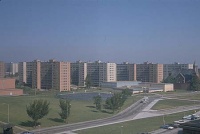Public housing
From The Art and Popular Culture Encyclopedia
|
"The origins of municipal housing lie in the dramatic urban population increase caused by the Industrial Revolution of the 19th century. In the large cities of the period, many social commentators, such as Octavia Hill and Charles Booth reported on the squalor, sickness and immorality that arose." --Sholem Stein |

|
Related e |
|
Featured: |
Public housing is a form of housing tenure in which the property is owned by a government authority, which may be central or local. Social housing is an umbrella term referring to rental housing which may be owned and managed by the state, by not-for-profit organizations, or by a combination of the two, usually with the aim of providing affordable housing.
Although the common goal of public housing is to provide affordable housing, the details, terminology, definitions of poverty and other criteria for allocation vary.
History
The origins of municipal housing lie in the dramatic urban population increase caused by the Industrial Revolution of the 19th century. In the large cities of the period, many social commentators, such as Octavia Hill and Charles Booth reported on the squalor, sickness and immorality that arose. Henry Mayhew, visiting Bethnal Green, wrote in The Morning Chronicle:
- ... roads were unmade, often mere alleys, houses small and without foundations, subdivided and often around unpaved courts. An almost total lack of drainage and sewerage was made worse by the ponds formed by the excavation of brickearth. Pigs and cows in back yards, noxious trades like boiling tripe, melting tallow, or preparing cat's meat, and slaughter houses, dustheaps, and "lakes of putrefying night soil" added to the filth.
Some philanthropists began to provide housing in tenement blocks, and some factory owners built entire villages for their workers, such as Saltaire in 1853 and Port Sunlight in 1888. It was in 1885, after the report from a Royal Commission in England, that the state first took an interest. This led to the Housing of the Working Classes Act of 1885, which empowered Local Government Boards to shut down unhealthy properties and encouraged them to improve the housing in their areas.
The City of London Corporation built tenements in the Farringdon Road in 1865. The world's first large-scale housing project was built in London to replace one of the capital's most notorious slums – the Old Nichol. Nearly 6,000 individuals were crammed into the packed streets, where one child in four died before his or her first birthday. Arthur Morrison wrote the influential A Child of the Jago, an account of the life of a child in the slum, which sparked a public outcry. Construction of the Boundary Estate was begun in 1890 by the Metropolitan Board of Works and completed by the then-recently formed London County Council in 1900.
The success of this project spurred many local councils to embark on similar construction schemes in the early 20th century. The Arts and Crafts movement and Ebenezer Howard's Garden city ideas led to the leafy London County Council cottage estates such as firstly Totterdown Fields and later Wormholt and Old Oak. The First World War indirectly provided a new impetus, when the poor physical health and condition of many urban recruits to the army was noted with alarm. In 1916, 41% of conscripts were unfit to serve. This led to a campaign known as Homes fit for heroes and in 1919 the Government first compelled councils to provide housing, helping them to do so through the provision of subsidies, under the Housing Act 1919. Public housing projects were tried out in some European countries and the United States in the 1930s, but only became widespread globally after the Second World War.
See also
- Fuggerei (The world's oldest social housing complex still in use.)
- Welfare state

